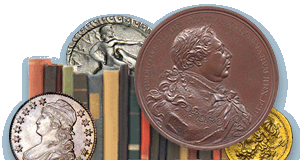
PREV ARTICLE
NEXT ARTICLE
FULL ISSUE
PREV FULL ISSUE
TREASURE TALK WITH BOB EVANS, EPISODE 5.2In January, our good friend Bob Evans began publishing a series of blog articles on the Finest Known website detailing his experience as co-discoverer and curator of the treasures recovered from the wreck of the S.S. Central America. Subject of the book "Ship of Gold", many exhibits, countless interviews and articles, books and auction catalogs feature the legendary haul of gold coins, bars, nuggets, gold dust and more from the 1857 shipwreck. Here's another excerpt - see the complete article online. -Editor
The objective is to alter the rust just enough that it loses its physical grip on the surface of the coin. Again, the bond is physical, not chemical. In very rare instances large pieces of blackish (oxygen-poor) rust spall off the coins and ingots, showing perfect reverse impressions of the gold surface. The impression is so exact and detailed (down to microns) that the microscopic flow lines from the dies, struck into the coin and imbuing it with mint luster, is replicated in this process of rust mineralization, making a perfect duplication of the original die. A "coin fossil." Lustrous rust! Except for just a few specimens, those with outstanding aesthetic eye appeal and relatively stable deposits, I removed the rust from all the coins. As a geologist, I liked the rust. It was an important part of the mineral context where we found the gold. But I understand the decision given the modern numismatic scene, where high grade coins are graded and encapsulated by third-party grading services. So, the decision was made to curate almost all the gold, to remove the rust and mineral deposits, but to take great care in not affecting the surfaces in any other way. It is a delicate and painstaking process. To begin with, let's talk about those iron oxides in micron-precise physical contact with a mint-state gold surface. These minerals are harder than the gold. Considerably harder. Pushing a flake of rust across a gold surface could scratch it. So, coaxing the rust off the surface is challenging and commands full attention. My preference is to do this in a bath of the solution, under a binocular microscope, using a sable-hair artist's brush as the only tool. The rust and calcium carbonate on the shipwreck have encased and obscured the dazzling gold, but these minerals also perform another fascinating role. In many cases coins and ingots were stuck together, with the minerals acting as cement between the pieces. The result could be "clusters" of coins, for instance a roll of four stacked double eagles. In one case there was a natural wonder we called "The Tower." The Tower was originally a box of $20 gold coins. Sometime between 1857 and 1988, the box had been eaten away by shipworms and other animals. Before the wood of the box disintegrated the coins inside were cemented together by the minerals. The resulting pile seemed to defy gravity. Rolls of coins were neatly stacked side by side in a single, solid "rock" comprising over 300 coins. This became a prime candidate for mass retrieval.
To read the complete article, see:
For the complete series, see:
To read the earlier E-Sylum article, see:
Wayne Homren, Editor The Numismatic Bibliomania Society is a non-profit organization promoting numismatic literature. See our web site at coinbooks.org. To submit items for publication in The E-Sylum, write to the Editor at this address: whomren@gmail.com To subscribe go to: Subscribe All Rights Reserved. NBS Home Page Contact the NBS webmaster 
|






